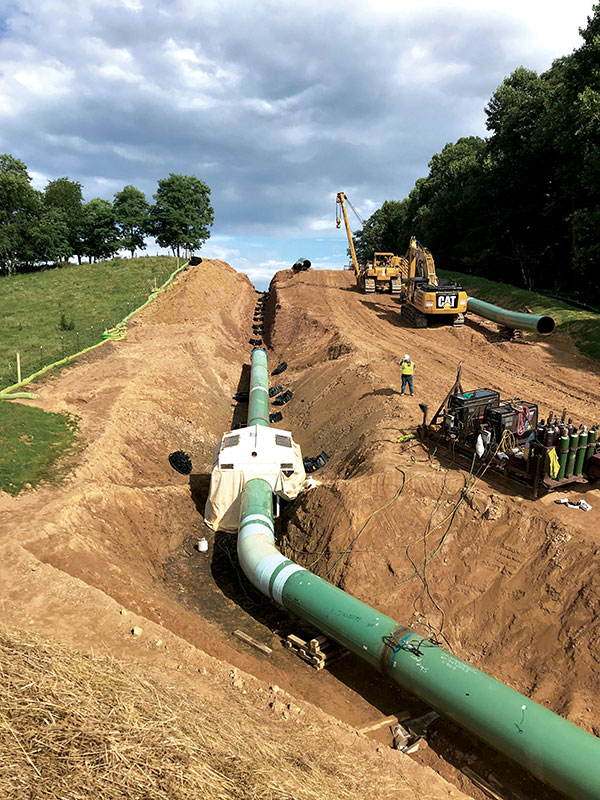U.S. Appalachian Gas Pipeline Projects Go by the Wayside
(Reuters) — In recent years, U.S. production of natural gas has soared, turning the country from a net importer of the fuel to an exporter, largely due to growth in the Appalachian region in Pennsylvania, Ohio and West Virginia.

Along with that 60% gain in output over the past decade came numerous proposed pipeline projects to move that gas to markets in the Midwest and Northeast and to points south to export terminals to ship overseas as liquefied natural gas (LNG).
However, many of the proposed pipelines to deliver gas to nearby locales have been scuttled in recent years, running into local opposition to fossil-fuel infrastructure, regulatory problems, or protests from environmental groups.
The most recent casualty was the PennEast pipeline from Pennsylvania to New Jersey, which would have drawn gas from the Marcellus shale in Pennsylvania.
Gas output in Appalachia has jumped from about 4.7 billion cubic feet per day (bcfd) in 2011 to around 34.9 bcfd now, representing more than a third of the 91.4 bcfd of U.S. dry gas produced in 2020.
One billion cubic feet is enough gas for about 5 million U.S. homes for a day.
Here are some of the recent projects that have run aground or failed to get started, along with a few significant pipelines that took extra time to complete.
ATLANTIC COAST
The $8 billion Atlantic Coast pipeline was being constructed from West Virginia to meet growing gas demand in Virginia and North Carolina. The 600-mile (966-km) project was originally started in 2018 and was designed to carry 1.5 bcfd of natural gas.
However, cost overruns, legal battles and issues with permits during the Trump administration caused Duke Energy Corp and Dominion Energy Inc to eventually decide to cancel the project.
The pipeline would have supplied enough gas for about 7.5 million U.S. homes a day.
MOUNTAIN VALLEY PIPELINE (MVP)
This pipeline was originally projected as another one that would extend from West Virginia to Virginia.
The 303-mile line will cost about $6.2 billion and bring enough gas for roughly 10 million U.S. homes a per day.
When MVP started construction in February 2018, it estimated the 2.0-bcfd project would cost about $3.5 billion and enter service by late 2018. Now, MVP expects the project to startup in the summer of 2022.
CONSTITUTION PIPELINE
This long-in-the-works project faced steady opposition from New York State lawmakers, particularly ex-Governor Andrew Cuomo.
Several energy companies tried for years to build gas pipelines from the Marcellus shale in Pennsylvania to New York, but regulators in Albany denied those projects.
Williams Cos Inc's 125-mile Constitution line would have transported enough gas for about 3.25 million homes per day.
Constitution filed with New York state regulators to build the line in 2013 but was unable to secure permits for water crossings. The line was canceled in 2020.
PENNEAST
PennEast Pipeline was under development for several years but was canceled due to a lack of permits in September 2021.
PennEast decided to stop development even though the U.S. Supreme Court in June ruled in its favor in a lawsuit allowing the line to seize state-owned or controlled land in New Jersey.
The 120-mile pipe would have cost about $1.2 billion and was designed to deliver 1.1 bcfd from the Marcellus shale to customers in Pennsylvania and New Jersey.
NORTHERN ACCESS
National Fuel Gas Co's (NFG) roughly $500 million Northern Access pipe was designed to supply about 0.5 bcfd of gas from Pennsylvania to upstate New York.
When federal energy regulators approved the project in February 2017, they required NFG to put the pipe into service by February 2019.
NFG, however, was not able to get all the necessary permits from New York, and has since asked federal regulators for more time to finish the project. So far federal regulators have given NFG, which has not started work on the project, until February 2022 to put the pipe into service.
Related News
Related News

- Keystone Oil Pipeline Resumes Operations After Temporary Shutdown
- Freeport LNG Plant Runs Near Zero Consumption for Fifth Day
- Biden Administration Buys Oil for Emergency Reserve Above Target Price
- Mexico Seizes Air Liquide's Hydrogen Plant at Pemex Refinery
- Enbridge to Invest $500 Million in Pipeline Assets, Including Expansion of 850-Mile Gray Oak Pipeline
- Evacuation Technologies to Reduce Methane Releases During Pigging
- Editor’s Notebook: Nord Stream’s $20 Billion Question
- Enbridge Receives Approval to Begin Service on Louisiana Venice Gas Pipeline Project
- Mexico Seizes Air Liquide's Hydrogen Plant at Pemex Refinery
- Russian LNG Unfazed By U.S. Sanctions




Comments